 |
|
Here and There introduces art, artists, galleries and museums around Japan that non-Japanese readers and first-time visitors may find of particular interest. The writer claims no art expertise, just a subjective viewpoint acquired over many years' residence in Japan.
|
|
 |
|
|
 |
 |
At Play in the Forests of Tabito: Art Meeting 2014
Alan Gleason |
 |
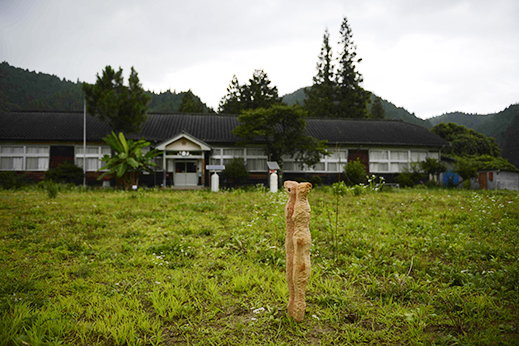 |
|
Eisaku Ando, Pupa of Light, wood, 100 x 20 x 20 cm |
The disasters, both man-made and natural, of March 2011 initially seemed to plunge many Japanese artists into a state of paralysis, but within months one could witness an outpouring of creative endeavor that continues to this day. Meanwhile, some communities in northeastern Japan that were affected by those catastrophes have turned to art as a way of bringing people together, not to mention attracting visitors and media attention to these tourism-starved regions.
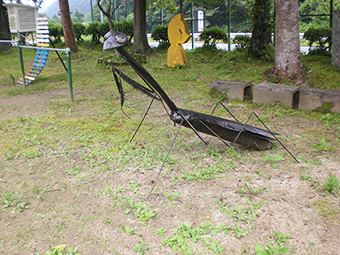 |
|
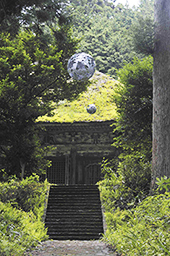 |
|
|
|
Shigeo Anzai, Man Holding a Sickle, steel, 2.5 m |
|
Yoshikazu Karikomi, Untitled, three spheres |
The results of such efforts are mixed. Some attempts to jump-start local economies with art festivals and the like have been hastily conceived and short on content or staying power. Sometimes, however, a fortuitous blend of committed individuals, talent, hard work, and good planning gives birth to something sublime, as it promises to in Tabito this month.
The town of Tabito nestles amid the green hills of the coastal Abukuma Range on the southern boundary of Fukushima Prefecture. Located 60 kilometers southwest of the Fukushima Dai-Ichi Nuclear Plant that melted down in 2011, it is outside the no-go zone and was never evacuated; today radiation levels are about the same as in Tokyo, 150 kilometers further south. Yet the community has suffered inordinately from the disaster, as have many other places with the misfortune of owning a Fukushima address.
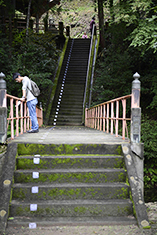 |
|
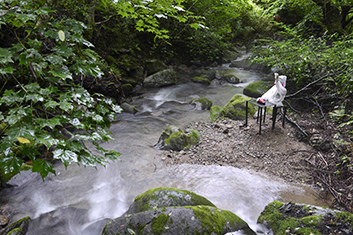 |
|
|
|
| Yoshiyuki Takashima, Relations, August 2013, rice paper |
|
DWARF (Makoto Nagaoka), 2012.6.18~, 150 x 150 x 150 cm |
Since 2011 Tabito has seen an exodus of residents, particularly the many newcomers who had moved from cities to this bucolic area in search of the simple life. Among the consequences of depopulation is the closure of five local schools to date. Now, however, some of those facilities are being put to use as venues for an annual art festival that has taken on new life in just the past year or two.
Art Meeting began 13 years ago as an artist-initiated event featuring outdoor works installed against a magical backdrop of forests, fields, streams, moss-covered temples and old wooden schoolhouses. Even before 2011 it occurred only sporadically, then went on hiatus in the wake of the earthquake and the violent aftershocks that followed. Last August, however, the festival reemerged in a bigger, better-organized format achieved through active collaboration between the artists and the Tabito Regional Development Council. With over 40 participants and some 3,000 visitors, the weeklong Art Meeting 2013 proved a solid if modest success.
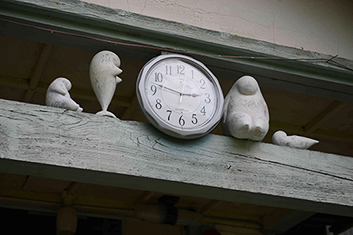 |
|
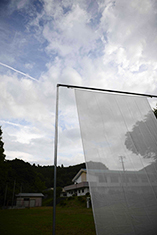 |
|
|
|
| Hiroko Hasegawa, Thank You So Much, Very Sorry, Forgive Me, I Love You, wood, 125 x 15 x 15 cm |
|
Kenji Yanagi, The Memory of Wind, cloth, steel pipe, 400 x 350 cm |
This month, Art Meeting 2014 builds on last year’s accomplishments with an even more ambitious program of installations, workshops and performances that runs for three weeks, from August 2 through 24. More than 60 artists and performers are on the roster, including several from overseas and nearly all of last year’s participants. The works shown here are those exhibited by some of this year’s artists in 2013.
|
 |
|
|
|
Naomi Seki, Rules of Meeting, white cement, etc. mixed media |
The organizers stress that Art Meeting is not be confused with the by now clichéd campaigns to “revitalize communities through art” that have come and gone over the past decade or two of economic doldrums. Nor, they aver, is the event intended to play on art lovers’ sympathies by harping on the tragedies of the earthquake and the nuclear accident. Yet there is no denying that the specter of radiation, and the fear it engenders, has had an overwhelming, nearly fatal impact on Tabito over the past three years. This fact is not lost on visitors, nor on the artists themselves, many of whose works address the nuclear theme. Whether such anxieties translate into great art or not is a hit-or-miss matter. What guarantees that Art Meeting 2014 will be worth the trek is not this fraught backstory, but the ineffably gorgeous natural setting against which the artists and performers will be acting out their concerns.
 |
|
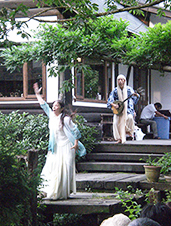 |
|
|
|
Ayako Kato, Untitled 2, dance at Art Meeting 2013 opening event,
3 August 2013 |
|
Yoya (bouzouki) and Noriko Kumagai (dance), Magic Forest, Dalliance of Water God, performance at Art Meeting 2013 closing event,
11 August 2013 |
All photos courtesy of Art Meeting and the Tabito Community Center
|
|
 |
Art Meeting 2014 (in Japanese only)
|
| |
2 - 24 August 2014 |
| |
Festival poster with map
Tabito Web Magazine |
| |
Minami-Ohdaira Branch, Tabito 2nd Elementary School and other venues
Tabito Town, Iwaki City, Fukushima Prefecture
Phone: 0246-69-2226 (Tabito Community Center)
Transportation: 10 minutes by car from Iwaki-Nakoso Interchange, Joban Expressway, 2 hours driving time from Tokyo; or 2 1/2 hours from Tokyo by train to Nakoso Station on the JR Joban Line |
|
|
|
|
 |
Alan Gleason
Alan Gleason is a translator, editor and writer based in Tokyo, where he has lived for 28 years. In addition to writing about the Japanese art scene he has edited and translated works on Japanese theater (from kabuki to the avant-garde) and music (both traditional and contemporary). |
|
|
|
|
|
|
|
|
|
 |
|